Recent viewing: November 2015
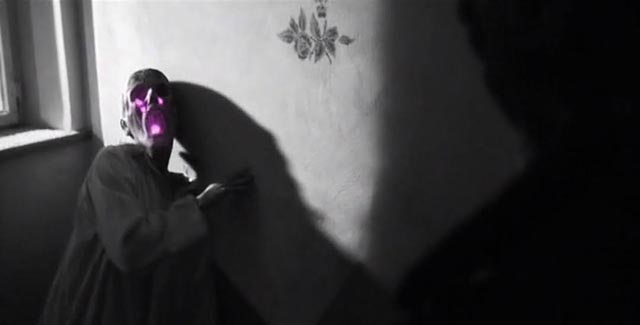
I’ve just moved to a new apartment, after more than sixteen years in the old one. It’s been a bit of a nightmare because I’m a pack-rat with thousands of DVDs, Blu-rays, books and CDs. It’s at times like this that I wish I lived a life of zen-like emptiness. There were moments when I thought I should just toss all this stuff instead of carefully packing it into boxes to be hauled over to the new location where I would only have to unpack it all again and arrange everything as neatly as I can on inadequate shelves. But, of course, the urge to possess is too strong.
To complicate things, I’ve been asked to give a speech in a couple of weeks about the disappeared movie theatres of Winnipeg, so in the midst of upheaval, I’ve had to pull together some of the research I did for my documentary three years ago, come up with a coherent thesis and write the damn thing! All while working a full-time job …
Which is all by way of making an excuse for a less than in-depth post this week. Just a few quick thoughts about some of the movies I’ve watched in the past couple of months but haven’t commented on yet.
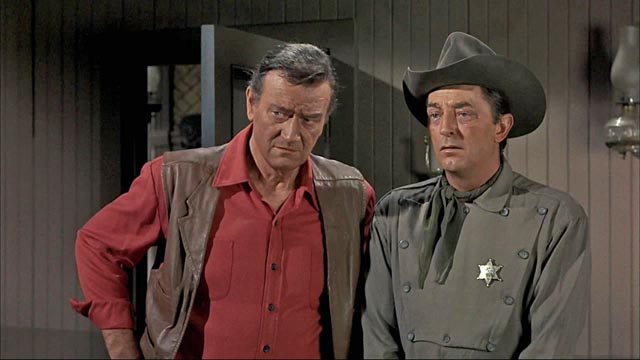
El Dorado (Howard Hawks, 1966)
On the whole, I tend to prefer Howard Hawks to John Ford. Ford’s mythologizing of the West often rubs me the wrong way, while Hawks’ easy-going naturalism seems less strained to me. El Dorado was a kind of loose remake of Hawks’ own Rio Bravo, with similar character dynamics and storyline – a ragged group of decent men facing off against a vicious gang which is oppressing a small western town. Four years after El Dorado, Hawks made yet another loose variation in his final film, Rio Lobo (1970). All three were written or co-written by Leigh Brackett, so the similarities are far from accidental.
El Dorado is a less well-constructed movie than Rio Bravo, but it has one of John Wayne’s best performances as ageing gunfighter Cole Thornton, stoically dealing with a very painful bullet lodged near his spine, courtesy of a feisty young woman, Joey MacDonald (Michele Carey), who mistakes him for someone hired to drive her family off their property. In addition, Robert Mitchum is in top form as the pathetically drunk sheriff J.P. Harrah (as good as Dean Martin might be in the parallel role in Rio Bravo, Mitchum towers above him with the low-key authority of a true movie star).
While the film rambles through its narrative with little sense of urgency, it’s full of excellent performances and fine character details, making it something like a comfortable visit with an old but cherished relative. The Blu-ray repeats all the extras from the 2009 two-disk DVD edition, including commentaries by Peter Bogdanovich and Richard Schickel, both well worth a listen, a 42-minute documentary about the making of the film and a couple of additional short featurettes, one about western artist Olaf Wieghorst, whose paintings serve as background for the opening titles, the other with Paramount executive A.C. Lyles reminiscing about John Wayne.
*
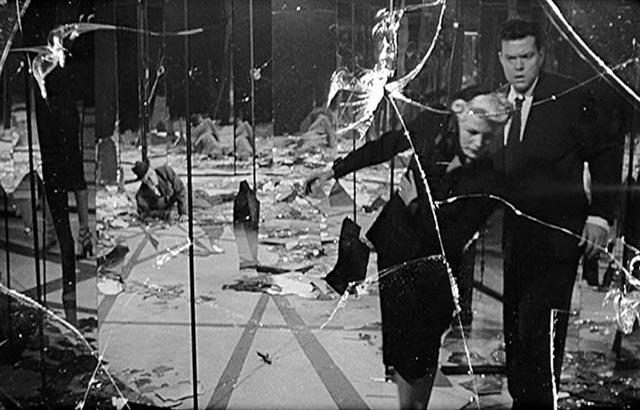
The Lady From Shanghai (Orson Welles, 1947)
While The Lady From Shanghai isn’t one of my favourite Welles’ pictures (I’d rank it with, say, Mr. Arkadin aka Confidential Report, 1955), it is nonetheless an engaging noir with a convoluted, at times obscure plot – perhaps a less comedic relative of John Huston’s shaggy-dog confection Beat the Devil (1953). Welles, with a broad Irish brogue, plays sailor Michael O’Hara, a drifter who gets sucked in by the wiles of Elsa Bannister (Rita Hayworth, Welles’ wife at the time), who’s married to crippled lawyer Arthur Bannister (Everett Sloane). O’Hara is hired on as crew on Bannister’s yacht, surrounded by shady characters and apparently being set up to take the fall for a murder. The details of the plot remain murky, but Welles executes it with his usual dazzling style (including the famous hall-of-mirrors climax). It’s an entertaining film, with a great cast, but one wonders whether it might have been more if it hadn’t been (yes, once again) taken away from Welles and re-cut by the studio.
The Blu-ray from bargain-bin company Mill Creek is surprisingly good, with an excellent rendition of a 4K transfer, but no extras.
*
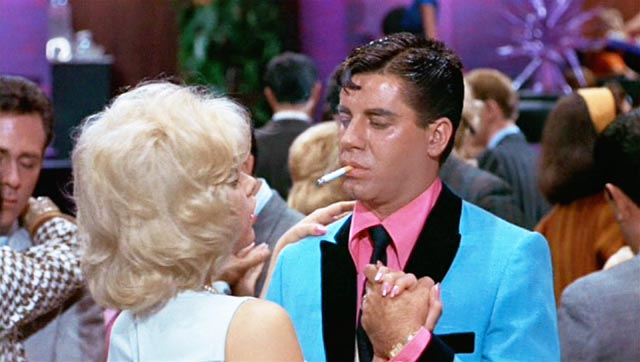
The Nutty Professor (Jerry Lewis, 1963)
Like most people my age, I first encountered Jerry Lewis on a small black-and-white television as a child. His goofy, mugging persona was tailored for kids, who could see something of their own clumsy social awkwardness in his shtick, an awkwardness which would inevitably be validated as a kind of authenticity by the movie’s end. He was the quintessential anti-adult and we came away feeling reassured that things would turn out okay for us in the end.
It’s long been a joke that the French hold Lewis in high esteem, while the rest of us think of him as nothing more than that immature goof. I certainly went off him not long after adolescence, finding his physical contortions, jutting teeth and grating voice an embarrassment. But still, that odd contradictory opinion held by the French has always lurked in the background. And so, when HMV recently offered a deeply discounted sale price on the 50th anniversary edition of The Nutty Professor (generally held to be his best film), my interest was piqued and I picked it up.
The first surprise was discovering that Lewis’ nerdy Professor Julius Kelp isn’t as cringe-worthy as I expected. Yes, he sticks out his teeth, twitches, speaks with a grating, high-pitched voice … and yet the performance is actually quite controlled, even restrained, compared to my memory of it. But of course, it’s not Kelp who gives The Nutty Professor its interest; it’s Kelp’s alter-ego, the insufferably egotistical Buddy Love, a rather vicious caricature of Lewis’ old comedy partner Dean Martin, a smoking, drinking sexual predator who believes himself to be irresistible to women. He’s utterly obnoxious in an amusing way.
The movie, obviously heavily influenced by Frank Tashlin, who directed Lewis in six features, is eye-searingly garish in its use of colour, pushing it towards cartoonishness; its Jekyll-and-Hyde narrative shares more with old Warner Brothers cartoons than classic horror movies. I can’t say I laughed a lot while watching it, but I did appreciate the level of craft Lewis brought to the project both as director and performer.
And it’s certainly a great leap forward from the feature he directed two years earlier, also included in the set on DVD. The Errand Boy (1961) is a ragged, undisciplined movie which exists mainly to provide Lewis with opportunities to indulge in that broad, goofy shtick – making faces, falling over things, and generally causing chaos in and around a movie studio in a collection of disconnected gags, many of which just peter out without reaching an effective punchline.
I haven’t got around to watching the Tashlin-directed Cinderfella (1960), also included. Nor have I checked out all the extras, which include a Lewis commentary track, docs and featurettes, even a CD of prank phone calls.
*
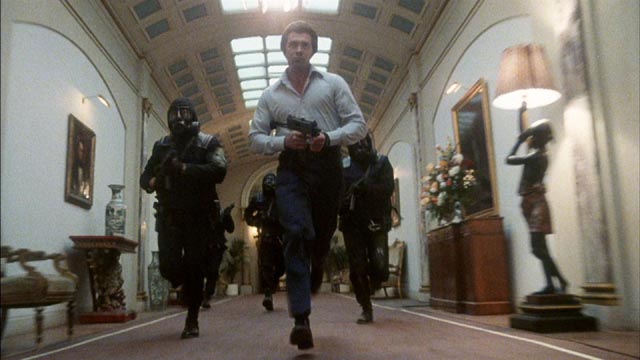
Who Dares Wins (Ian Sharp, 1982)
This thriller about an SAS officer infiltrating a group of radicals in London tries hard to emulate the Bond franchise while being more “realistic”. While the budget was quite large for a British movie of the time, it was paltry by Bond standards and it has a TV ambiance about it – perhaps not surprising, given that director Ian Sharp did most of his work both before and after for the tube. Producer Euan Lloyd did a string of action movies in the ’70s and ’80s, usually with solid casts of mid-level and occasionally major stars – the westerns Shalako (1968) and Catlow (1971), starring Sean Connery and Yul Brynner respectively; Andrew V. McLaglen’s The Wild Geese (1978) and The Sea Wolves (1980), the former with Richard Burton, Roger Moore and Richard Harris, the latter with Gregory Peck, David Niven and Roger Moore again. His final production was Wild Geese II (1985), directed by Peter Hunt and starring Scott Glenn.
When it was released, Who Dares Wins (the title is the motto of the SAS) was dismissed as a right-wing apologia for the secretive British military force. The SAS were so approving of the portrait it painted that they gave Lloyd a great deal of support in terms of technical advice and facilities; and no less than Ronald Reagan himself admired its depiction of stalwart soldiers thwarting power-mad Lefties. In fact, Reagan’s thumbs up, according to Lloyd in his commentary track, harmed the film’s box office performance by turning off left-leaning viewers.
Adding to the TV movie feel is a large collection of “guest stars” whose performances are mostly little more than walk-ons – Richard Widmark, Edward Woodward, Robert Webber, Ingrid Pitt, Patrick Allen, Kenneth Griffith… The actual star, however, is television actor Lewis Collins, whom Lloyd insists would have made a great Bond; yet he’s far outclassed by Judy Davis as the leader of the terrorists who take over the U.S. embassy and threaten to launch a nuclear strike to trigger a Third World War unless Britain unilaterally disarms. Yes, it’s the old case of confused activists who would destroy the world in the name of peace.
The film’s makers seem to have absolutely no moral problems with the married hero leaving his wife alone with a young baby while he moves in with the lead terrorist, initiating a sexual relationship in order to infiltrate the movement. This plot element seems less like macho movie fantasy now in light of revelations in Britain over the past few years of undercover cops establishing relationships with “radicals” to the degree of living with them, even having babies, not to mention possibly committing criminal, even terrorist, acts in order to discredit the groups they infiltrated. Seen through this lens, Lewis Collins’ character seems less heroic and far more sinister as a representative of a state at war with its own citizens.
Sharp keeps things moving fairly briskly through two-plus hours and some of the action is well-staged, but ultimately the movie doesn’t have anything to distinguish it from any number of other mediocre action thrillers from the ’80s.
Arrow Video’s Blu-ray looks reasonably good, and cinematographer Phil Meheux (following The Long Good Friday and the third Omen movie, The Final Conflict) gives it a gritty look. The commentary with Lloyd and director Sharp is quite informative about the production, the state of the British film industry at the time, and getting all that surreptitious help from the SAS. There’s also a 38-minute account of Lloyd’s producing career, and a 25-minute making-of made for a TV show at the time.
*
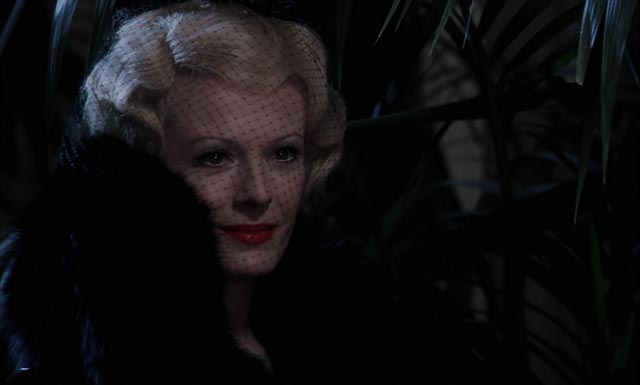
Daughters of Darkness (Harry Kümel, 1971)
The Blood Spattered Bride (Vicente Aranda, 1972)
In 1971, Belgian filmmaker Harry Kümel was asked by producer Pierre Drouot to make an exploitation movie, specifically a lesbian vampire film along the lines of Hammer’s recent The Vampire Lovers (1970) and Twins of Evil (1971). The resulting film certainly contained all the necessary elements – an atmospheric location, a young married couple drawn under the influence of a mysterious, glamorous woman and her mysterious, extremely erotic servant, brutal murders in which the victims are drained of blood, some kinky sex – but quite unexpectedly, all this is rendered with genuine art which supports a wonderfully nuanced performance by the great Delphine Seyrig as the 16th Century Hungarian Countess Erzsébet Bathory, a noblewoman made famous by her penchant for bathing in virgins’ blood to stay young. (In real life, the Countess was arrested, tried, and sentenced to be walled up in a small room – where she lingered for four years, fed through a small hole in the wall, before dying.)
On its initial release, Daughters of Darkness somewhat confused critics and audiences because there seemed to be an odd disconnect between the exploitation elements and the lush elegance of the production and the respectability supplied by Seyrig. In time, its reputation has solidified as one of the finest vampire films ever made, and a far cry from the crass Hammer films which inspired it.
After disappointing DVDs from Anchor Bay and Blue Underground, the latter’s Blu-ray (from 2011) finally does justice to the rich, saturated colours of the film’s imagery. The disk carries over all the extras from those DVDs: a commentary by Kümel, and another by co-star John Karlen in conversation with David Del Valle; interviews with Kümel and Drouot, and with actresses Danielle Ouimet (who played the young bride) and Andrea Rau (who played the Countess’ companion/servant).
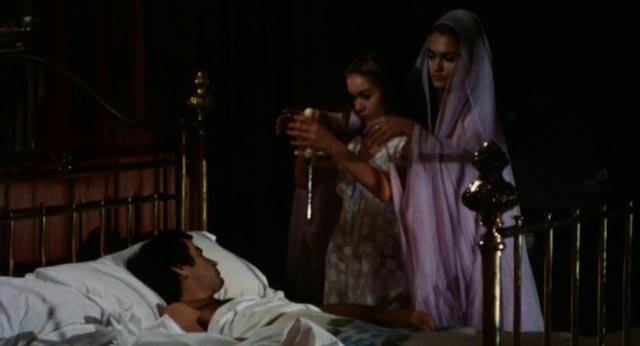
As an added bonus, the disk also includes the Spanish erotic vampire movie The Blood Spattered Bride (1972), like so many of its kind from that era very loosely based on Sheridan Le Fanu’s novella Carmilla (1871). A young bride returns to her sadistic husband’s estate, where his violence combines with her own repressed sexual desires to conjure up Mircalla Karnstein, a vampire who inspires her to fulfill those desires. Once again, all the exploitation elements are there, but director and co-writer Vicente Aranda has none of Kümel’s skill. The movie is sluggishly paced, crude rather than artful, and lacks even the cheesy energy of Hammer’s Karnstein trilogy.
*
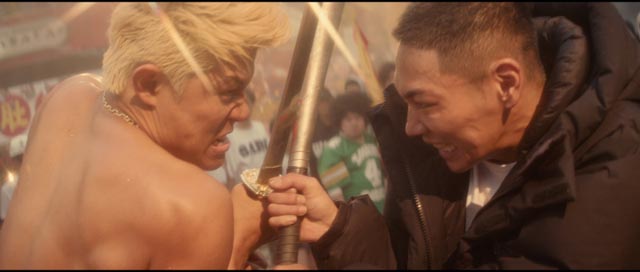
Tokyo Tribe (Sion Sono, 2014)
Although not quite as prolific as his contemporary Takashi Miike, Sion Sono is as transgressive as, and at times far more ambitious than, his better-known countryman. (He also seems to be trying to catch up, with no less than seven films listed on IMDb for 2015.) I’ve been a fan since seeing Suicide Circle almost a decade-and-a-half ago. Like Miike, his output is uneven, but almost every film is interesting for stylistic reasons, as well as for the skewed light it throws on Japanese society. His work is a remarkable mixture of thematic sophistication, stylistic innovation, and an at times gleeful appropriation of pulp content. The four-hour Love Exposure (2008) is an emotional epic centred on up-skirt fetishism; The Land of Hope (2012) is a moving portrait of displacement and loss in the wake of the Fukushima nuclear disaster, while Himizu is a less naturalistic treatment of the trauma following the tsunami (released just ten months after the event); Cold Fish (2010) and Guilty of Romance (2011) are savage examinations of violent crime which come across like the supercharged children of Imamura Shohei’s Vengeance Is Mine (1979).
And so, coming on the heels of Why Don’t You Play In Hell? (2013), his blackly comic update of yakuza movies in the digital age, I had high hopes for Tokyo Tribe (2014). Like a hyperactive homage to Walter Hill’s The Warriors (1979) and Streets of Fire (1984), Sono’s movie depicts an alternate future Tokyo ruled by street gangs and criminals; when one gang moves to take over the city, the others have to put aside their differences and join forces to fight the bad guys. The city is designed in the colourful, hyperreal style of Streets of Fire and Blade Runner, the action is directed in a frenzied display of cast and camera choreography – and the whole thing is performed as a kind of rap opera.
And this, in the end, was my big problem with the film. I found the music kind of dull and monotonous, with very little variation in tone and tempo throughout. Instead of energizing the comic book narrative (based on a manga by Santa Inoue), it paradoxically makes the whole thing drag uncharacteristically, as if having to stage everything to accommodate the music had reined Sono in. Personally, I think the dense, multi-faceted narrative would have played better straight (like Why Don’t You Play in Hell?) … but that’s just me.
The Eureka region B Blu-ray includes a long collection of behind-the-scenes footage plus some deleted scenes.
*
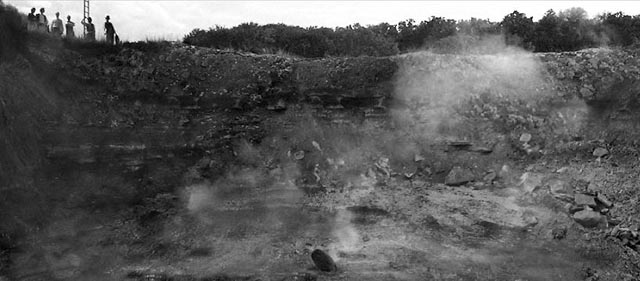
Die Farbe (The Color Out Of Space) (Huan Vu, 2010)
As I’ve mentioned here before, H.P. Lovecraft has inspired more “fan movies” than perhaps any other author. And paradoxically, these amateur or semi-professional movies turn out to be better and more faithful than bigger budget, more mainstream adaptations. The German production Die Farbe (The Color Out Of Space), written and directed by a young German-born Vietnamese filmmaker named Huan Vu, is a cousin of sorts to Andrew Leman and Sean Branney’s The Call of Cthulhu (2005) and The Whisperer in Darkness (2011). But despite much of it being “in period”, it has a more digital look than either of those films. Shot in widescreen black-and-white interrupted only for appearances of the titular colour, a kind of radioactive force which maddens and transforms people it touches, the film follows an American man to Germany, where he tries to trace his recently vanished father and uncovers strange events which affected his father immediately after the end of World War Two.
After a slightly rocky start (the brief prologue in the U.S. is awkward and stilted), the film takes its time and remains low key as it tells the story of a small farming community plagued by the mutating force from space in the years leading up to the war. There’s a slight suggestion that the colour is a metaphor for the effects of Naziism on the German people, but it’s not fully realized; and while the film is fairly atmospheric, its moments of horror are muted and in the end it kind of peters out. Nonetheless, the production is quite impressive and shows real ambition.
The limited edition Blu-ray from BRINKvision (just 1000 copies) provides a strong image, with Martin Kolbert’s digital cinematography generally creating a film-like look. Several featurettes cover the production and the effects, as well as taking a look at Lovecraft’s work; the technical background stuff is quite interesting as the film turns out to be loaded with digital enhancements to landscapes and backgrounds which are seamlessly blended with the live action, showing just what is now possible on a very small budget. In addition, there are links to audiobooks of a number of Lovecraft’s stories (these seem to be amateur efforts, many of which are a strain to listen to).
(Lovecraft’s story was subsequently adapted again by Swedish filmmaker Henrik Möller in 2014 as Feed the Light, and by Richard Stanley in 2019 under its original title.)
Comments